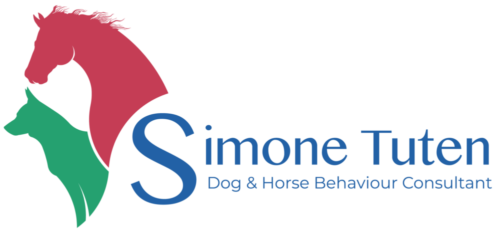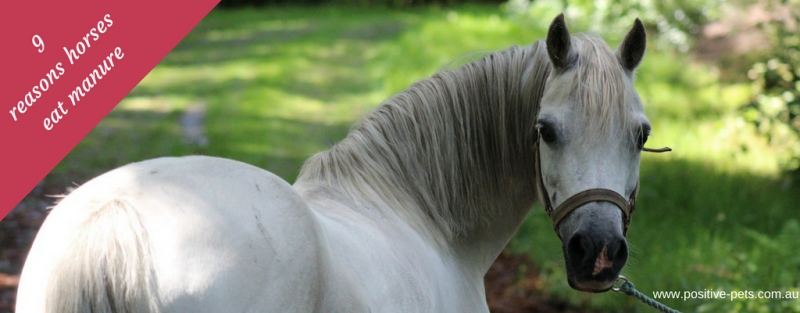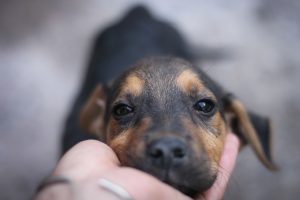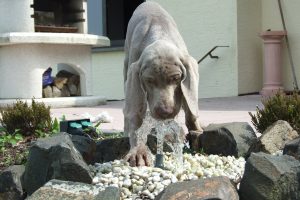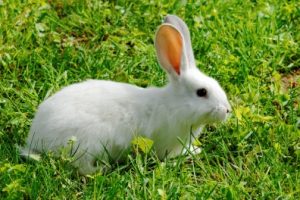Horses eat manure? Disgusting? Abnormal? That depends. Technically called coprophagy, eating manure is a normal, but transient, stage of a horse’s natural development.
Foals will eat manure, usually fresh from their dam, from about 5 days old. This behaviour is common until the foal reaches 3 months of age, at which point eating manure gradually reduces and stops by 19 weeks (Waring 2003; Crowell-Davis and Houpt 1985).
How common is common? One report found that foals ate manure once per 4.3 hours of observation time for the first two months of age (Crowell-Davis and Houpt 1985). Another source reports foals eat manure every 4-9 hours (Waring 2003). The amount of manure eaten is quite small, and often follows the foal pawing the fresh manure.
Interesting but why do horses eat manure? Let’s look at the reasons why a foal eats manure and then the reasons why an adult horse will eat manure (and what you can do about it).
 Why do foals eat manure?
Why do foals eat manure?
1. Kick start the digestive system
This is the most commonly known reason for foals to eat manure. The healthy horse’s digestive system contains many microbes including bacteria, protozoa and fungi. At least 50 species have been found in horse digestive systems (Egan et al. 2010).
Early work by A. A. Strelkow published in 1939 found an average of 7.7 species of microbes per horse in the caecum and ventral colon; with an average of 16.6 species found in the dorsal colon to small colon. It is thought that most of the microbial populations found in a horse’s hindgut establish during a foal’s early days; when the foal’s stomach is less acidic (Egan et al. 2010).
2. Learning about safe plants to eat
From about 1 week old a foal starts exploring foliage by mouthing rather than ingesting plants (exploratory grazing). This behaviour decreases suddenly between 2 and 3 weeks old. Between the ages of 4 and 6 weeks foals start to display adult like grazing behaviour, selecting grass rather than non-grass (weeds) and starting to avoid poisonous plants (Marinier and Alexander 1995, McGreevy 2012, Waring 2003).
A link has been reported between the appearance of selective grazing and the coprophagy stage in a foal’s development (Marinier and Alexander 1995; McGreevy 2012, Mills 2010). Another report suggests that coprophagy in horses is a way the horse learns food preference. This type of learning is interesting as it occurs directly through neural pathways from the digestive tract to the brain, rather than through cognitive processes (McLean 2001).
3. Obtaining deoxycholic acid
It is believed that a mare’s faeces contains a pheromone which encourages the foal to eat it. Based on work with rats it is believed that the faeces contains deoxycholic acid (Crowell-Davis and Houpt 1985, Crowell-Davis 1986, Mills 2010).
Deoxycholic acid supports digestive system immunity (protects against enteritis) and promote myelination of the nervous system (essential for neurological development) (Crowell-Davis and Houpt 1985, McGreevy 2012).
 Why do adult horses eat manure?
Why do adult horses eat manure?
Eating manure is considered to be an abnormal behaviour in horses (other than foals) and is rarely seen. The most common reasons mature horses eat manure is inappropriate diet and poor nutrition.
4. Diet low in fibre
Diets low in fibre have been linked to horses eating manure (Waring 2003, Furr and Reed 2008, Geor et al. 2013). Horses on a mixed grass/legume hay are less likely to eat manure than horses fed a concentrate diet (Waring 2003, Elia et al. 2010). Free access to forage eliminated coprophagy in Przewalski horses (Boyd 1988).
5. Underfed
Free roaming horses have been observed to eat old manure when food is scarce (Waring 2003). Under these situations mares and foals have been observed eating from stallion piles (Waring 2003). Underfed domestic horses can resort to eating manure (Mills 2010).
6. High starch diet
Despite access to a lot of hay, horses fed a diet high in starch may eat manure. Starch is found in grains like corn, oats and barley. Replacing a portion of the starch with fat has eliminated both aggression and coprophagy in horses (Hothersall and Nicol 2009).
7. Feeding frequency
Free ranging horses eat for between 10 -18 hours per day and rarely go longer than 3 hours without eating (Harris et al. 2017). Stabled horses spend 8.5 – 12 hours per day on foraging behaviours which includes eating bedding and manure (Harris et al. 2017, Geor et al. 2013).
It is possible that coprophagy in horses may be due to a need to eat more frequently than meals are provided. Gut fill, time since last meal and a decrease in glucose levels have been suggested as reasons for horses to eat manure (Geor et al. 2013, Hothersall and Nicol 2009).
8. Medical conditions
Eating manure has been seen in horses with medical conditions such as equine motor neuron disease (EMND) (Geor et al. 2013, Divers et al. 1994). The most commonly identified risk factor for EMND is a lack of grazing for more than one year and poor quality hay (Divers et al. 1994).
9. Vitamin K deficiency
Furr and Reed (2008) report that horses eating manure may be a sign of vitamin K deficiency, especially if the horse also has a reduced blood-clotting time.
What to do?
If your horse eats manure then please:
a) Consult your veterinarian to rule out medical reasons and discuss your horse’s condition and diet
b) Consult an equine nutritionist to ensure the horse’s diet is balanced and includes a lot of hay
c) Ensure the horse has constant access to appropriate grazing or hay
For horses that need a restricted diet and cannot have constant unlimited access to grazing or hay contact me and we can discuss options that limit how much your horse eats, yet extends the time your horse spends eating.
If you found this post useful, please leave a comment or share the post.
References
Boyd, L. E. (1988) Time budgets of adult Przewalski horses: effects of sex, reproductive status and enclosure. Applied Animal Behaviour Science 21: 19-39 https://www.sciencedirect.com/science/article/pii/0168159188900998
Crowell-Davis, S. L. (1986) Developmental Biology. Veterinary Clinics of North America: Equine Practice 2(3): 573-590 https://www.sciencedirect.com/science/article/pii/S0749073917307071
Crowell-Davis, S. L. and Houpt, K. A. (1985) Coprophagy by foals: effect of age and possible functions. Equine Veterinary Journal 17(1): 17-19 https://onlinelibrary.wiley.com/doi/abs/10.1111/j.2042-3306.1985.tb02030.x
Divers, T. J., Mohammed, H. O., Cummings, J. F., Valentine, B. A., De Lahunta, A., Jackson, C. A. and Summers, B. A. (1994) Equine motor neuron disease: findings in 28 horses and proposal of a pathophysiological mechanism for the disease. Equine Veterinary Journal 26(5):409-415 https://onlinelibrary.wiley.com/doi/abs/10.1111/j.2042-3306.1994.tb04411.x
Egan, C. E., Snelling, T. J and McEwan, N. R. (2010) The onset of ciliate populations in newborn foals. Acta Protozoologica 49: 145-147 http://www.ejournals.eu/sj/index.php/AProto/article/view/3851
Elia J. B., Erb, H. N. and Houpt, K. A. (2010) Motivation for hay: effects of a pelleted diet on behaviour and physiology of horses. Physiology & Behavior 101 (5): 623-627 https://www.sciencedirect.com/science/article/abs/pii/S0031938410003380
Furr, M. and Reed, S. (eds) (2008 ) Equine neurology. Blackwell Publishing Available from Amazon
Geor, R. J., Harris, P. A. and Coene, M (eds) (2013) Equine applied and clinical nutrition. Saunders Elsevier Available from Amazon
Harris, P. A., Ellis, A. D., Fradinho, M. J., Jansson, A., Julliand, V., Luthersson, N., Santos, A. S. and Vervuert, I. (2017) Review: feeding conserved forage to horses: recent advances and recommendations. Animal 11(6): 958-967 https://www.cambridge.org/core/journals/animal/article/review-feeding-conserved-forage-to-horses-recent-advances-and-recommendations/6D9383943C1E35D5F699964F1C9CA2C6
Hothersall, B and Nicol, C (2009) Role of diet and feeding in normal and stereotypic behaviors in horses. Veterinary Clinics: Equine Practice 25: 167-181 https://www.vetequine.theclinics.com/article/S0749-0739(09)00004-2/abstract
Mariner, S. L. and Alexander, A. J. (1995) Coprophagy as an avenue for foals of the domestic horse to learn food preferences from their dams. Journal Theoretical Biology 173: 121-124 https://www.sciencedirect.com/science/article/pii/S0022519385700495
McGreevy, P. (2012) Equine behaviour – a guide for veterinarians and equine scientists. Saunders Elsevier Available from Amazon
McLean, A. N. (2001) Cognitive abilities – the result of selective pressures on food acquisition. Applied Animal Behaviour Science 71: 241-258 https://www.appliedanimalbehaviour.com/article/S0168-1591(00)00181-7/fulltext
Mills, D. S. (2010) Encyclopedia of applied animal behaviour and welfare. CAB International Available from Amazon
Waring, G. H. (2003) Horse Behavior (2nd ed). Noyes Publications/William Andrew Publishing Available from Amazon
